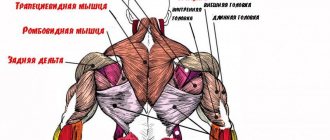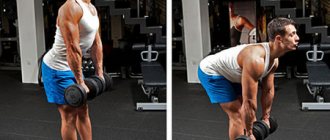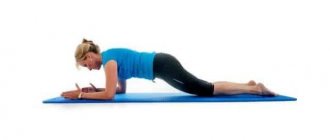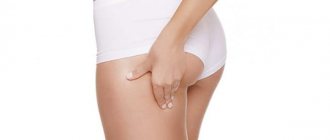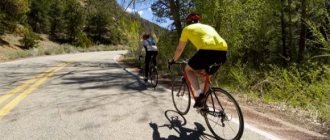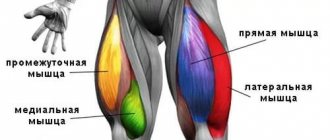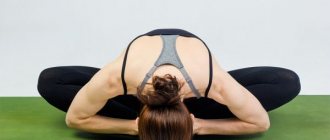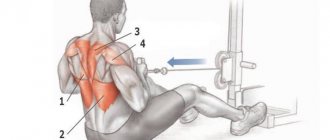Author: Timko Ilya - the ruler of the entire site and fitness trainer | more details >> Rod. 1984 Trained since 1999 Trained since 2007. Author and creator of the site tvoytrener.com. CCM in powerlifting. Champion of Russia and South Russia according to AWPC. Champion of the Krasnodar region according to IPF. 1st category in weightlifting. 2-time winner of the Krasnodar Territory championship in t/a. Author of more than 700 articles on fitness and amateur athletics. Author and co-author of 5 books.
Place in the author rating:
out of competition
(become an author)
Date:
2012-05-29
Views:
701,491
Rating:
4.3
| All articles by the author >> | Medals articles >> |
Articles are loading...
| Article medals: | article in TOP 100 | more than 500 thousand views |
Why medals are given to articles:
| Bronze medal: | |
| 1. The article is in the TOP 100 2. The article has more than 3. The article has more than 100 | |
| Silver medal: | |
| 1. The article is in the TOP 50 2. The article has more than 3. The article has more than 500 | |
| Gold medal: | |
| 1. The article is in the TOP 10 2. The article has more than 1 3. The article has more than 1,000 | |
Main muscles - pectoralis major Additional - none (with correct technique) Difficulty of execution - easy
What does it develop and what is the name of the simulator?
So, the abduction and extension of the legs in a sitting machine help us in training the legs, but these two movements are aimed at different muscles: if the extension of the legs is aimed at training the muscles of the outer surface of the thigh, then the abduction is aimed at training its inner surface . The exercise is an isolation exercise. Suitable for both women and men.
By the way, it often happens that the simulator is capable of performing only one movement: either adduction or extension. It depends on the design of the simulator. To tell the truth, this is terribly inconvenient in our opinion, but the gym needs to be filled with something. Many fitness centers have these machines. Their design includes a soft seat, a lever system, a compartment for weight adjustment and two stops equipped with soft bolsters, against which the knees rest.
It is difficult to make a mistake in performing these exercises, since they are simple and understandable.
What muscles work
When spreading the legs while sitting, which muscles are involved:
- abductors - adductors, gluteus medius and minimus.
- Stabilizing muscles: quadratus dorsi, erector spinae and abdominal muscles.
Dear girls, we remind you that by developing these muscles, you will not reduce the amount of fat in this problem area. The main task of the leg abduction and abduction exercise in the simulator is to strengthen muscles, and not to get rid of fat deposits.
An article explaining why everything is so unfair: Why don’t we lose weight locally or how to burn fat?
Muscle atlas when bringing the legs together :
- adductors are the muscles of the inner thighs. An important point: they are very little involved in everyday life.
What simulators are suitable for these purposes?
- To perform the exercises, you can use equipment such as a gymnastic ball.
- Special expanders.
- Dumbbells.
- Special exercise machines, some models of which can only be installed in the gym.
Among the simulators, a simulator that has special doors, which, in turn, have special protrusions for positioning the legs and are connected to a load, can help in putting this part of the body in order. When the sashes are brought together, the load rises, and when they are moved apart, it lowers. The load placed on the muscles of the inner thigh can be adjusted. By decreasing or increasing the load being lifted.
Special expanders used to strengthen the muscles of the inner thigh are equipment that has two metal loops, which are covered with soft and durable material. Thanks to the spring mechanism located at the junction of the hinges, they are located at an angle of ninety degrees relative to each other.
Expander
When pressure is applied to the hinges, the angle decreases; after the pressure is removed, they return back. A gymnastic ball is simply a rubber ball filled with air.
It is worth noting that in addition to special machines designed to work the muscles of the inner thighs, this area can be affected by such cardio machines as an exercise bike, bicycle, stepper and elliptical, which promote the loss of fat deposits and generally tidy up the leg muscles.
Technique with photos: how to do it correctly?
As we wrote above, the exercises are not complicated and do not require any special skills. So, how to do it correctly with and without a simulator:
Sitting
Performing leg reduction in the simulator:
- Set the required weight for the weights on the machine and adjust the position of the backrest. Take a starting position in which your legs are spread apart and rest against the bolsters or cushions of the machine, straighten your back and rest it against the back of the seat.
- Legs should be bent at an angle of 90 degrees or more. Take a deep breath.
- As you exhale, tighten your hips and begin to bring your legs together. Do not change the angle of leg bending.
- At the finishing point (legs are completely brought together), stay in this position for 1-2 seconds and tighten the hip adductors as much as possible.
- Starting to inhale, spread your legs slowly, without jerking, while observing the technique. Do not bring your legs to the starting position in order to leave the muscles in a tense state. Repeat the movements several times in accordance with the training program.
Dear, I accelerated my metabolism or myths about “hyped” metabolism
How to use the breeding machine:
- Take your starting position. Sit on the machine so that your thighs are between the side supports. Grasp the handles with your hands, straighten your chest and straighten your back. Now you can start spreading your legs in the simulator.
- As you inhale, tighten your abs and spread your legs as far apart as possible. Hold in the extreme position for a few seconds.
- Slowly return to the starting position and exhale. Your legs should move towards each other not under the pressure of the exercise pads, but as if resisting it. This means that we do not completely relax the muscles and perform the movement completely under control.
Since these exercises relate to isolation, you should not chase the scales. Very often, girls, inspired by the ease of execution, begin to boast a little about their “strength” and quickly increase the weight. Isolation is just your assistant, your main tool is the queen base (basic exercises). If you don’t do the base or add fillet when doing it, then you can say goodbye to a beautiful body, 100% guarantee.
We are not saying that isolation is bad, no! Isolation exercises greatly help us to qualitatively load a muscle that is previously fatigued by the base. And then there are those unique people who lift and raise 40 kg, but squat every other time and barely.
Conclusion: insulation is good, but without a base it’s still impossible.
We strongly recommend that you familiarize yourself with the technique of performing basic exercises: Do the basics, beauty! .
Bent over
If the machine allows you to change the angle of the backrest, take advantage of this chance. By performing leg raises while sitting in a backward bend, you will maximally load the target muscles - the gluteus medius and minimus.
Reduction and extension with forward bend:
If you keep your body straight or lean forward, the upper part of the gluteus maximus muscles will engage. By the way, another great exercise for the so-called “upper buttocks” is gluteal swings .
Standing
To do this, we turn our backs to the standing exercise machine and the bolsters, grab the back of the chair with our hands and rest our knees against it. The back should be straight and the pelvis should be slightly back. As you exhale, we bring our legs together, resting our feet on the bolsters, and as we inhale, we spread them apart. The legs should not move by inertia - tension should always be present.
Or this option.
From the lower block in the crossover
As for the gym, a replacement for leg extensions can be a side swing from the lower block, which works the thigh muscles. For greater effect, you can first work out with blocks, and then proceed to the “adjustable” simulator.
With elastic band
An interesting option for exercising at home is a real home gym! There are a lot of variations, it all depends on your convenience and imagination. Here are some ideas:
- Extension and abduction of legs while lying on your side . Place the resistance band on your shin for added resistance on your outer thigh. We raise our leg, hold it at the peak point of tension, and lower it. Don't lean forward or backward or turn your hips in or out. During movement, the core muscles also work. Keep the feet of both feet parallel. By turning your feet toes, you will work your hip external rotators.
- Sideways on your knees
- Lateral exercise while lying on your back on the floor . Take a lying position, straighten your arms along your spine, lift your legs up. Spread them apart and bring them together with an elastic band stretched over your shins. Move the resistance band higher if the exercise seems too difficult. You can also make it a plus by lifting your pelvis upwards and then bringing your legs together!
- Sitting on a chair for women . Sit on a chair/sofa/bench. Place the elastic band above the knees, on the hips: this way the load will fall much better than when the expander is located just below the knee. Place your feet so that the band is taut and the load is felt. Lean your body forward. Extend and contract your knees, holding at the highest point of tension for 3 seconds. In it, make pulsating movements, but not back and forth, but only forward, spreading your legs wider!
Breeding legs in a simulator for varicose veins - read the True answer, is it possible to play sports with varicose veins
Street trainer
Tips for Maximum Benefit
- Before performing the exercise, stretch your hip joints and stretch your inguinal ligaments. This will allow the muscles to better absorb the load and also increase the range of motion. You can see effective joint gymnastics in this article .
- Make sure your back remains straight . Under no circumstances should you hunch your back on the last reps! If you don't have the strength left, shorten the exercise or help yourself overcome the resistance with your arms.
- Work slowly and avoid sudden movements. Try not to use the force of inertia.
- Cool down plays an important role . Your muscles will only be flexible enough if you don't skip post-workout stretching, which helps flush out lactic acid from your muscles, thereby relieving the soreness that usually occurs the day after a workout.
What to replace it with?
The leg abduction and abduction exercise machine cannot be called very effective. It can be replaced with the exercise “Steps with a rubber band to the sides” and a plie squat .
- Technique for performing exercises with a tape: Attach the tape to your ankles and, stretching the projectile, take small steps left and right. Then stand with your feet straight, shoulder-width apart, toes pointing to the sides. Keeping your back straight and your buttocks lowered, lower yourself into a squat so that your thighs are parallel to the floor. Return to the starting position. For clarity, watch the video.
By the way, these exercises will help you solve the problem of “walking” knees when squatting. It is very common for those who begin to squat with a barbell to experience knee cramps as soon as they add weight to their back. This is a common problem, but it can be solved with these exercises. You will strengthen the small muscles and ligaments that hold the kneecap and teach yourself to keep your knees straight.
It is better to leave the exercise for finishing, after the squat.
- Plie squat quite easy to do. Stand up straight, statically tense your abs and pick up the dumbbell at the base/kettlebell by the handle. Stand with your feet wider than shoulder-width apart, knees slightly bent, and feet pointed outward (to about a 45-degree angle). Turning your feet 45 degrees is purely conventional, your legs should be placed as far as the flexibility of your body allows without compromising your technique, so that you feel comfortable. Place the dumbbell between your legs. This is the starting position.
As you inhale, begin to lower yourself down, slowly bending your knees. The knees should not go beyond the feet and should not be brought together, but should seem to go to the sides (work like scissors). Lower yourself until your thighs are parallel to the floor. As soon as you feel a good stretch in the adductor muscles, exhale and return your body to the starting position, pushing your heel off the floor.
Those. inhale - we go down, exhale - we go up. Repeat the specified number of times. At the top of the movement, do not lock or lock your knees. Correct execution should cause a feeling of tension in the quadriceps, inner thighs and buttocks.
Throughout the entire movement, keep your back straight and the apparatus close to your body. Your arms should not “walk”, but they should not pull weight either; try to transfer the entire load to the buttocks. How to do it? You will find the answer in the article “ Concentration in training: shaking your butt with your head .” Be sure to pay attention to the pace: do the exercise smoothly and without jerking.
If you have difficulty maintaining balance, do plie squats with your back against the wall. It is better to put the exercise at the beginning of the workout, and do a 5-10 minute warm-up before it. Do not lower your head or look at your feet; it is better to turn sideways to the mirror and record the quality of your technique. For greater depth of squat and accentuated development of the buttocks, you can use step platforms under each of the legs.
How to effectively pump up Madame Sizhu: plie and sumo squats
Exercise technique
While sitting on a seat, it is necessary to overcome a given resistance by bringing your legs together. The technique of performing the exercises is not particularly difficult and is accessible even to beginners.
The first thing you need to do is set the appropriate level of resistance - be it a free weight machine or a block weight machine. Then sit comfortably, keeping your back straight. The legs must be bent at the knees, spread apart and set to the set width. You need to firmly grasp the handrails with your hands and take a comfortable position to prevent “fidgeting.” This will be the starting position for starting classes.
Bringing the legs together is done smoothly while exhaling, avoiding jerking to the most extreme position. In this position, you must forcefully hold your legs for 1-2 seconds to ensure static benefits. Try not to neglect this recommendation.
As you inhale, you should begin to slowly spread your legs. In this case, you should try to stop a little in advance before the final position, not allowing the muscles to relax and keeping them in constant tension. The exercise must be done a specified number of times, and then rest. The number of approaches depends on the individual training program.
What to combine with?
Exercises on this machine can be used as auxiliary to the main ones (or rehabilitation in case of injury) and included at the end of the workout , but working only with it will not give any progress in improving the shape of the legs, remember this and do not fall for the machine as an exclusive one for training muscles inner thigh.
I think a reasonable question has arisen: why are such not very effective exercise machines installed in gyms? The answer is that if they did not exist, fitness centers would discourage most of their female clientele from visiting them. Coupled with the fact that women are afraid of free weights and becoming too big and muscular, it is easier for them to choose a light load for themselves.
So ladies, when it comes to improving the shape of your inner thighs, use the adductor machine wisely and don't focus on it alone.
Seated hip adduction
Author: Antonov Andrey
Iron World.
No. 3.2014. Hip adduction in a sitting machine is one of the most popular exercises among women visiting fitness centers. Men pay much less attention to this exercise. Working in static-dynamic mode allows you to quite effectively remove fat deposits from the inner thighs, an area that is problematic for many women. More details about this mode of operation can be found in the article: “Local fat burning is possible! Interview with Professor Seluyanov,” which was published in an issue of our magazine.
This exercise is also known as seated leg raises. But it is anatomically correct to say a cast. Let's analyze the exercise
Exercise:
single-joint, that is, insulating.
Working joint:
hip.
Impact on major muscle groups
: comb m., long adductor m., short adductor m., large adductor m., thin m.
Starting position (IP):
sitting in the exercise machine, your back and pelvis are pressed against the support, your feet are on the pedals.
Movement:
on exhalation – adduction of the hip, on inhalation – return to I.P.
Guidelines:
range of motion of one leg is 45 degrees. That is, the angle between the thighs should not exceed 90 degrees.
The pace of the exercise is slow, especially in the negative phase. In a state of full adduction, it is advisable to take a short pause (fixation).
The exercise is quite easy. Possible injuries on it may be associated with sprained groin ligaments. Therefore, it is not recommended to do it with a large amplitude. The main point of safety precautions is to sit on the machine when the moving arms of the machine are fixed in the adduction position. And only after this should you remove the fixation and abduct the hips to the required angle, and then fix the position.
Also, after completing the exercise, before standing up, it is necessary to remove the fixation, perform full adduction of the hips until the stops touch, and fix the levers of the simulator in this position. By following these two simple recommendations, you will minimize the risk of injury.
You shouldn't really chase the scales. These muscles are little used in everyday life, except when moving sideways, side steps and dancing. By performing standard strength training, you can significantly increase the muscle mass of the hip adductors, which can lead to varus (O-shaped) curvature of the legs. Remember the proverbial bowleggedness of cavalrymen? This is not a myth. Constant load on the muscles of the inner thigh in a power mode contributed to the hypertrophy of these muscles. The disproportion between the tone of the muscles of the inner surface of the thigh and the muscles of the outer surface of the thigh leads to this type of curvature of the legs.
But for people with valgus (X-shaped) curvature of the legs, this exercise is recommended to be performed in the power mode. Increasing the tone of the muscles of the inner thigh is the main non-surgical way to get rid of this pathology.
| Email Contacts and links |
Harm
Let us immediately ask you to note that we are not declaring that this simulator is harmful. Exercises on this machine are useful in moderation with small weights and a small total monthly volume of their use. They really create muscle tone in the abductor and adductor muscles of the thigh, improve the tone of the gluteus medius and minimus muscles, and improve blood circulation in these places.
However, they do not remove excess fat at all and, moreover, these exercises can even be harmful.
(Degree of tediousness: acceptable)
We have already mentioned that the range of motion in this simulator is unnatural for the body, i.e. This movement is not used anywhere outside the gym. And the adductor muscles themselves (which this exercise is aimed at) do not work very much in life. These muscles are a complex of muscles located deep on the inner surface of the thigh and groin. They are difficult to find, because... they are “buried” under other muscles, such as the quadriceps. You use these muscles when climbing stairs, climbing hills, and standing up. Progress in weight comes quite quickly, but the higher it is, the more it strains the spine. The kneecap will also not thank you for the ever-increasing load.
How to reduce the stress on your knees when playing sports?
Thus, it turns out that no matter how you use the leg adduction machine, it most likely will not change your leg composite composition, for these purposes it is a useless tool. And it's all about the biomechanics of movement. The design of the exercise machine itself is sedentary, so the thigh muscles do not work in any way in this position. It often happens that people come to the gym after a hard, sedentary day in order to get their blood flowing and tone their muscles.
And, oddly enough, they choose on their own (or on the advice of a trainer) a sedentary machine to train their muscles. This is not true. Exercises that require balance and use free weights and weighted walking/standing should be selected. In particular, leg tucks can be replaced with cross lunges or leg abductions on a block - they allow you to achieve significantly better “tuning” of the legs.
What has been written should not be taken as a complete failure of the adductor simulator to work the corresponding muscles.
The main harm is that when you spread your legs in the exercise machine in a large volume, and especially with good weights, the piriformis muscles gradually develop and spasm .
The origin of the piriformis muscle is on the anterior surface of the sacrum, and it is attached to the femur. The function of the piriformis muscle is abduction and supination of the hip. Below the piriformis muscle is the sciatic nerve , the longest nerve in the body, running from the lower spine, through the buttocks and thighs, and down the back of the leg. Although this nerve is found in both legs, symptoms of a pinched sciatic nerve usually appear in only one leg.
Have you ever felt, when performing this exercise, that your thigh was “cramping” , some kind of aching pain when moving to the sides, deep inside? No, this is not a muscle that you pumped up so well, it’s a poor nerve asking for mercy.
Pinching symptoms:
- The very first symptom of a pinched sciatic nerve is pain, which usually begins in the lower back and spreads along the entire length of the nerve: through the buttocks, to the thighs and calves. The intensity of pain can vary from mild to very acute. Sometimes the pain manifests itself in the form of a burning sensation, in other cases it can be similar to electric shocks.
- Another common symptom of a pinched sciatic nerve is numbness that affects part or all of the leg. Numbness in one area may be accompanied by pain in another. In addition, usually a person also experiences a characteristic tingling sensation in the toes.
- One of the most distressing symptoms of a pinched sciatic nerve is loss of bladder or bowel control. This condition is rare and requires emergency medical attention. Sometimes this symptom of a pinched sciatic nerve is accompanied by lumbosacral radiculitis.
When the legs are brought together in the simulator, with a spasmodic piriformis muscle, even greater compression of the sciatic nerve occurs and symptoms worsen or appear.
Conclusion : this machine can be used in your training program, but with light weights and a maximum of 1 time per week.
The role and importance of the hip adductors and abductors for triathletes
The abductor and adductor muscles work synchronously as you move (abduct and pull) your legs to the sides. The abductors are responsible for moving the leg away from the midline of the body, and the adductors are responsible for moving the leg back toward the midline of the body.
You've definitely seen exercise machines for these muscle groups in the gyms (they are similar in design), girls love to work out on them. While sitting, you open or close your bent knees with appropriate resistance.
What muscles work during the mechanism of abduction and adduction of the legs?
If we go into detail, the hip abductors include the gluteus medius, gluteus minimus, and tensor fasciae lata, while the adductors are basically the small muscles on the inside of the thigh, in addition to the adductor magnus. .
From an aesthetic point of view, these muscles are easy to notice in well-developed bodybuilders. The adductors fill out the “thigh” between the hamstrings, and the abductors help round out the outer gluteus muscle.
The abductor and adductor muscles are often overlooked, even by those who engage in high-level strength training, be it powerlifting or bodybuilding. They are often thought of as secondary muscles; many people in the gym will favor more classic exercises - the squat or press, for example, which, although they require some abductor/adductor engagement, will not have the same value as training them directly.
What exactly do these muscles do?
It's not just bodybuilders who need to know about these muscles - triathletes can benefit from pumping them up too.
The abductors play an important role in stabilizing the hips and buttocks, reducing and avoiding knee pain (important aspects of running). In one study, runners with patellofemoral syndrome experienced increased strength and decreased pain after just three weeks of abductor muscle training (). The adductor muscles are required to perform several functions, including adduction, flexion, and medial rotation of the femur.
As for the adductor muscles, strengthening them is associated with a decrease in groin pain in many athletes. Workouts don't have to be long or intense, just include resistance training/cool-down exercises like what football players do (). In another study, a control group of soccer players (the most injured athletes in this component) performed strengthening exercises and had 41% fewer groin problems than the group that did not do these exercises ().
How can you pump up the abductor and adductor muscles?
Triathletes and many other athletes often already have a complex and varied training program, how do you fit abductor and adductor training into it?
Fortunately, these muscles do not require a full workout. You can incorporate them into your workout at the gym, whether it's strength training or plyometric work. You can do abductor/adductor work as a warm-up, cool-down, and as part of your balance and core work.
Strength/strengthening exercises
It doesn’t matter if there is no gym with the above-mentioned exercise equipment. Aim for 12-15 reps to reduce the risk of injury, and focus on staying within your active range of motion and controlling your form. Three approaches should be enough.
– Wide stance squats. The legs are much wider than the shoulders, the feet are directed outward, which forces the knees to use a large number of abductor muscles.
– Lunges in motion. To engage more adductor and abductor muscles, try to increase your step length (even though this is contrary to the classic lunge technique).
–
.
– Lateral lunges (lunges to the side). In fact, the step is taken both to the side and forward, an angle of approximately 45 degrees. Then return your leg to the starting position.
– Leg abduction with rubber shock absorber while sitting. Analogous to the load in a special simulator. Just sit on a bench or chair, attach shock absorbers to your knees and move your legs in different directions. An additional benefit is that you pump up your abdominal muscles and more. Almost the same can be done while lying on your side, moving one leg up (to the side) with an elastic band.
You don't have to do it all in one day, but try to include at least two exercises in your weekly plan.
Stretching the adductor and abductor muscles
These muscles need not only to be strengthened, but also to be stretched and relaxed. Believe me, from cycling and running, they contract very strongly (therefore, special strength + stretching and relaxation are needed). In fact, one most effective exercise for each muscle group is enough.
Adductor muscles:
Abductor muscles:
Maridav Shutterstock

